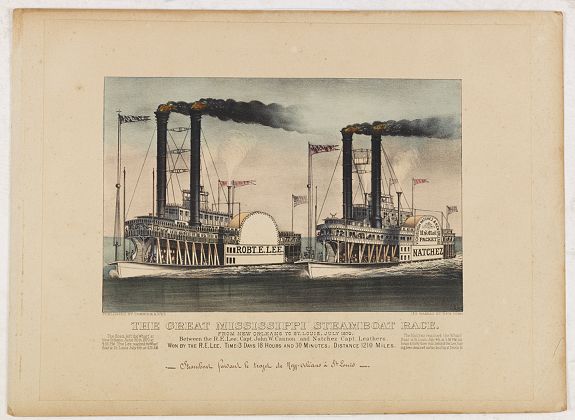Currier and Ives

Currier & Ives was a New York publishing firm that produced and sold
thousands of impressions of more than 7,000 different lithographic prints during the latter
half of the nineteenth century. One of the most prolific printmaking concerns of its time,
the firm originated with Nathaniel Currier (1813-1888) whose shop issued its first
lithographs in 1835.
In 1852 Nathaniel Currier was joined by his brother-in-law,
James Merritt Ives (1824-1895). The firm operated until 1907."
All Currier & Ives prints are marked with the address at the substructure of each print.
Currier & Stodart, 1834, 137 Broadway
N. Currier, 1835, 1 Wall Street
N. Currier, 1836 - 1837, 148 Nassau Street
N. Currier, 1838 -1856, 152 Nassau Street & 2 Spruce Street
Currier & Ives, 1857-1865, 152 Nassau Street & 2 Spruce Street
Currier & Ives, 1866 -1894, 152 Nassau Street & 33 Spruce Street
Currier & Ives, 1894 -1896, 108 Fulton Street and 33 Spruce Street
Currier & Ives, 1896 -1907, 33 Spruce Street
Images include genre
scenes, illustrations of progressive technology, American nationalism, historical scenes
and even leisure activities.
Most Currier & Ives prints are hand colored lithographs, although Currier & Ives did issue
several uncolored prints and a number of chromolithographs due to the high cost this process
was short-lived and are sought after by collectors.
The firm was unique in its capability to unite artistic talent, skilled craftsmanship,
appropriate expertise and merchandising shrewdness into a winning business venture. Under
employment or contract were renowned artists of the day including Maurer Palmer, Tait and
Worth were just a few who were in employment at different times. The Artistic awareness to
detail is apparent in the work, on examination of the clipper ship print or a country scene
will confirm the absolute quality of the prints. Only the premium materials were used: stones
from Bavaria (where lithography was invented), lithographic crayons from France, and colors
from Austria.
The firm contributed to technology by inventing a lithographic crayon,
reputed to be superior to any other available at the time. It also fashioned a lithographic
in which contained beef suet, goose grease, white wax, castile soap, gum mastic, shellac and
gas black. Ground-breaking merchandising techniques were used.
Mass circulation and low cost were the keys to success. Cost was essential. Uncolored prints
sold for as little as 20 cents each and ever large-colored folios sold for no then three
dollars. Prints were sold door-to-door by peddlers, in the streets by pushcart vendors,
in geographically remote places through distributors, and even overseas through agents.
Although an estimated ten million prints were sold only a small percentage are in existence today.
A large number of notable artists created images, among them are James E. Butterworth, George Durrie, Otto Knirsch, Charles Parsons,
Napoleon Sarony, Arthur Fitzwilliam Tait, William Walker, Thomas Worth.
Interesting reading:
- Currier & Ives Prints. An Illustrated Checklist. Frederic A. Conningham. Updated by Colin Simkin.
- Visit the American Historical Print Collectors Society (www.currierandives.com)